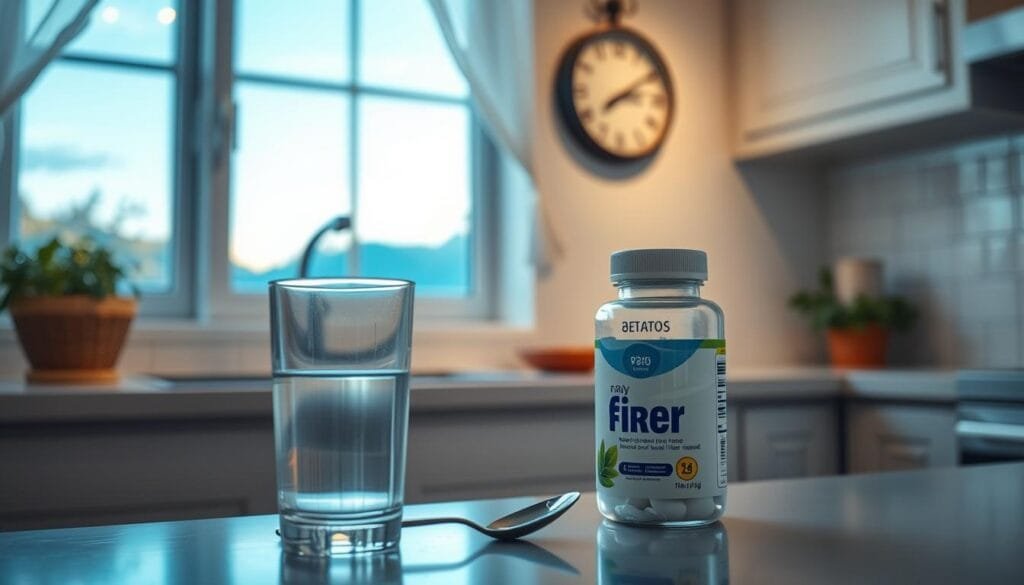Currently Empty: RM0.00
Most adults struggle to meet daily nutritional targets, especially for essential nutrients like dietary fiber. Recent studies reveal that 93% of Americans consume less than half the recommended intake. This gap impacts digestion, energy levels, and long-term wellness, creating a growing interest in practical solutions.
Timing plays a crucial role in how effectively the body absorbs nutrients. For those considering adding soluble or insoluble sources to their diet, understanding when to take them can enhance benefits like blood sugar balance and gut health. This guide explores science-backed strategies to align intake with individual routines and goals.
Factors like meal schedules, hydration habits, and personal biology influence ideal timing. Some people benefit from spacing their intake, while others prefer consistency. The article will break down how different approaches affect digestion and which patterns suit specific lifestyles.
Key Takeaways
- Most adults consume less than 50% of their daily fiber needs
- Timing impacts nutrient absorption and digestive comfort
- Individual factors determine ideal intake schedules
- Consistency often outweighs specific timing choices
- Hydration enhances effectiveness regardless of schedule
Understanding the Benefits of Fiber Supplements
Modern diets often fall short in providing essential nutrients, leaving many searching for reliable solutions. Adding these products to daily routines can address nutritional gaps while delivering targeted advantages for physical wellness.
Supporting Digestive Health
Soluble varieties absorb water to create a gel-like substance, easing stool movement through the intestines. This process reduces discomfort and encourages regularity. A thriving gut microbiome depends on these compounds to fuel beneficial bacteria growth.
Research shows certain types act as prebiotics, strengthening immunity and improving nutrient uptake. Consistent use helps maintain intestinal balance, particularly for those with irregular eating patterns.
Lowering Cholesterol and Managing Blood Sugar Levels
Viscous varieties bind to bile acids during digestion, prompting the liver to use existing cholesterol reserves. One study found combining psyllium with statins reduced LDL by 63 mg/dL – equivalent to some medications’ effects.
For glucose regulation, beta-glucan slows carbohydrate breakdown. Diabetic patients using this type saw A1C levels drop by 0.68%, supporting stable energy throughout the day. Discover more about the health benefits of fiber through whole foods and strategic supplementation.
These products work best when paired with adequate hydration and gradual dosage increases. While timing matters less than consistency, understanding individual needs helps maximize results.
Exploring Different Types of Fiber Supplements
Selecting the right nutritional boost starts with understanding the options. Products vary in how they interact with the body, making some better suited for specific goals than others. Let’s break down key categories and their unique roles.
Soluble vs. Insoluble Varieties
Soluble types absorb water to form a gel-like texture. This slows digestion, helping balance blood sugar and lower cholesterol. Psyllium husk is a popular choice here, often found in powders or capsules.
Insoluble varieties don’t dissolve. Instead, they add bulk to stool, speeding up its journey through the gut. Methylcellulose works well for sensitive systems, while glucomannan expands in the stomach to support appetite control.
Whole Foods vs. Concentrated Products
Apples, oats, and beans deliver nutrients alongside soluble and insoluble benefits. These foods also provide vitamins and antioxidants that enhance overall wellness. However, busy schedules sometimes make consistent intake challenging.
Concentrated products offer precise dosing for targeted results. They’re ideal for those needing higher amounts or managing dietary restrictions. A balanced approach often combines both sources for maximum impact.
| Type | Key Benefit | Common Sources | Best For |
|---|---|---|---|
| Soluble | Slows digestion, stabilizes glucose | Psyllium, oats, apples | Cholesterol management |
| Insoluble | Adds bulk, prevents constipation | Wheat bran, vegetables | Digestive regularity |
Choosing between options depends on individual needs. Those prioritizing heart health might lean toward soluble types, while others focus on gut motility. Always pair these products with plenty of water for optimal results.
How to Take Fiber Supplements Correctly
Proper usage techniques make all the difference between a smooth transition and digestive challenges. Whether managing specific health goals or bridging nutritional gaps, strategic approaches help the body adapt efficiently.
Starting Slow to Minimize Discomfort
New users often experience gas or bloating when increasing their intake too quickly. Begin with half the recommended dose for 3-5 days. Gradually add more every week until reaching the target amount.
This phased approach gives gut bacteria time to adjust. If cramps occur, reduce the quantity temporarily. Most discomfort fades within 10-14 days as the digestive system adapts.
Mixing with Water and Timing with Medications
Always stir powders into 8-12 ounces of water. Inadequate hydration can cause throat irritation or blockages. Pair each serving with an extra glass of fluids throughout the day.
These products may bind to medications if taken simultaneously. Experts recommend spacing them at least two hours apart. For example:
| Supplement Time | Medication Window | Benefit |
|---|---|---|
| 7:00 AM | 9:00 AM onward | Full drug absorption |
| 6:00 PM | Before 4:00 PM | Optimal nutrient uptake |
“Consistency matters more than clock-watching. Find a routine that aligns with your meals and existing habits.”
Track reactions in a journal during the first month. Adjust timing or quantities based on energy levels and digestive comfort. Those with diabetes or thyroid conditions should consult healthcare providers for personalized plans.
fiber supplement morning or night: Choosing the Optimal Time
Your daily rhythm could determine how well your body utilizes nutritional support. While consistency matters most, aligning intake with personal habits may enhance results.

Comparing Morning and Evening Benefits
Starting the day with a soluble blend helps manage hunger. Studies show this approach reduces midday calorie consumption by 12% compared to afternoon intake. Early hours align with natural cortisol spikes, which may improve metabolic responses.
Evening routines support overnight digestion. The gel-forming properties of certain types work gradually, promoting fullness that lasts until bedtime. This timing suits those wanting to avoid late snacks while supporting gut activity during rest.
“Participants who took viscous blends before dinner reported 22% fewer cravings compared to non-users.”
Medication schedules also influence decisions. Those taking thyroid drugs or antidepressants often benefit from spacing their intake by 3-4 hours. A simple comparison:
| Schedule | Key Advantage | Ideal For |
|---|---|---|
| Daytime | Appetite control | Weight management goals |
| Nighttime | Digestive support | Evening meal enthusiasts |
Track energy levels and bathroom patterns for 2-3 weeks when testing schedules. Most people find better results by matching intake to their most consistent daily habit rather than chasing “perfect” timing.
The Role of Fiber in Regulating Digestion and Blood Sugar
Balanced digestion and stable energy go hand in hand with proper nutrient processing. Certain dietary components play dual roles in maintaining gastrointestinal rhythm and metabolic balance.
Enhancing Bowel Movements
Insoluble varieties act like nature’s broom, sweeping through the digestive tract. They add bulk to stool, triggering muscle contractions that promote regularity. This process helps prevent sluggish digestion and supports comfortable elimination.
Studies show consistent intake can reduce transit time by 31% in adults with irregular patterns. For best results:
- Pair with adequate hydration
- Increase intake gradually
- Combine with physical activity
Stabilizing Blood Sugar Levels
Soluble types form a gel matrix during digestion. This slows carbohydrate breakdown, leading to steadier glucose absorption. Research demonstrates this mechanism can lower post-meal sugar spikes by up to 27%.
| Fiber Type | Effect on Glucose | Timeframe |
|---|---|---|
| Beta-glucan | Reduces A1C 0.68% | 12 weeks |
| Psyllium | Cuts spike intensity | Immediate |
“Participants using viscous blends saw 19% better blood sugar control than placebo groups in clinical trials.”
These effects make strategic nutrition valuable for maintaining energy balance and metabolic health. Tracking responses helps identify individual needs and optimal intake levels.
Timing Considerations: The Advantage of Evening Intake
Evening routines can unlock hidden benefits for digestive wellness. Strategic timing allows the body to process nutrients during its natural repair cycle, maximizing results while minimizing discomfort.

How Evening Use Supports Overnight Digestion
Consuming soluble blends 2-3 hours before bed creates ideal conditions for gut health. The slower nighttime metabolic rate lets these compounds work gradually, feeding beneficial bacteria that produce essential fatty acids.
This process often leads to more predictable morning bowel movements. A 2023 study found participants taking viscous blends in the evening experienced 40% fewer irregularity issues compared to daytime users.
| Evening Intake | Daytime Intake | Key Difference |
|---|---|---|
| Supports microbiome activity | Boosts daytime energy | Overnight fermentation |
| Reduces late cravings | Controls midday hunger | Appetite management |
| Gentler on digestion | Faster absorption | Metabolic pace |
The body’s rest-and-digest mode enhances nutrient processing during sleep. This natural rhythm helps minimize bloating since the gut isn’t simultaneously handling other meals.
“Nighttime users report 35% better digestive comfort compared to morning starters in clinical observations.”
Space intake at least two hours before bedtime for optimal results. Those managing medications can avoid morning conflicts while maintaining consistent daily benefits.
Practical Tips for Incorporating Fiber Supplements into Your Routine
Building sustainable habits makes nutritional support effortless. Whether managing wellness goals or boosting daily nutrition, small adjustments create lasting results. Start by anchoring your routine to existing patterns for seamless integration.
Daily Habits for Consistent Intake
Link your regimen to established rituals. Pair your intake with morning coffee or evening skincare routines. Visibility matters – store products near frequently used items like water bottles or meal prep containers.
Standardize preparation methods to build muscle memory. Mix powders with chilled herbal tea or blend into smoothies for variety. Tracking progress through apps helps identify patterns and maintain motivation.
- Pre-measure weekly portions in labeled containers
- Set phone reminders during low-stress periods
- Celebrate 7-day streaks with non-food rewards
Pairing Supplements with High-Fiber Foods
Combine products with whole-food sources for amplified benefits. Try chia pudding topped with raspberries or stir psyllium into oatmeal. This dual approach enhances gut diversity while delivering essential vitamins.
| Food Pairing | Fiber Type | Added Benefit |
|---|---|---|
| Black beans + supplement | Soluble/Insoluble | Extended fullness |
| Avocado + powder | Viscous | Heart health support |
Those following plant-based diets often see enhanced results. Experiment with global cuisines – lentil curries or roasted chickpea snacks add texture and nutrition.
Addressing Digestive Concerns and Side Effects
Many people experience temporary digestive changes when adjusting their nutritional intake. These shifts often result from the body adapting to increased soluble or insoluble sources in the diet.
Managing Gas, Bloating, and Cramps
Gradual introduction proves key. Starting with small amounts allows the gut microbiome to adjust without overwhelming it. Those noticing gas or bloating can reduce portions temporarily, then slowly rebuild tolerance over 7-10 days.
Hydration dramatically reduces discomfort. Pair each serving with 250ml of water, and maintain fluid intake throughout the day. Fermented foods like yogurt help counterbalance temporary effects by supporting beneficial gut bacteria.
Track meals and symptoms to identify triggers. Some find that spacing intake away from high-fat foods minimizes cramping. Gentle movement after consumption – like a 10-minute walk – often eases digestion.
Persistent discomfort may signal the need for formula adjustments. Soluble varieties typically cause fewer effects than insoluble types for sensitive individuals. Always consult healthcare providers if symptoms last beyond three weeks.
FAQ
How do soluble and insoluble fibers differ in their benefits?
Soluble types, like those found in psyllium or oats, dissolve in water to form a gel that helps lower cholesterol and stabilize glucose. Insoluble varieties add bulk to stool, promoting regular bowel movements and preventing constipation.
Can taking these products interfere with medication absorption?
Yes. To avoid interactions, it’s best to consume them at least two hours before or after prescriptions. Consulting a healthcare provider ensures personalized timing advice.
Why might evening intake be advantageous for some people?
Consuming them later in the day allows gradual digestion overnight, which can ease morning regularity and reduce sudden spikes in glucose after dinner. This approach suits those prioritizing gut health during sleep cycles.
What steps minimize discomfort like bloating when starting a regimen?
Begin with small doses—half a serving initially—and increase slowly over weeks. Pairing with plenty of water and meals rich in whole grains or vegetables helps the body adjust without distress.
Are natural sources better than packaged options for daily needs?
Whole foods like beans, berries, and leafy greens provide a mix of nutrients alongside dietary fiber. However, supplements offer convenience for those struggling to meet goals through diet alone, especially for targeted benefits like blood sugar management.
How does consistent intake affect long-term heart health?
Regular use of soluble varieties binds to bile acids, forcing the liver to use excess cholesterol for replacement. Over time, this process can reduce LDL levels, lowering risks of cardiovascular disease.
Should workouts influence when someone takes their dose?
For active individuals, morning consumption might align better with pre-exercise hydration routines. Evening timing, however, could prevent mid-activity urgency, depending on personal tolerance and schedule preferences.


